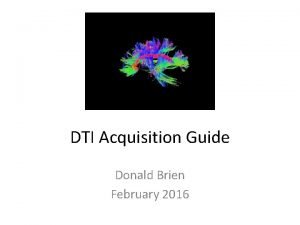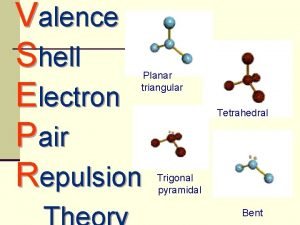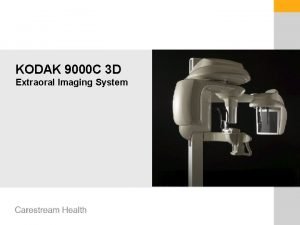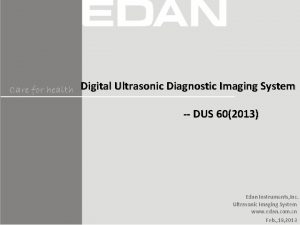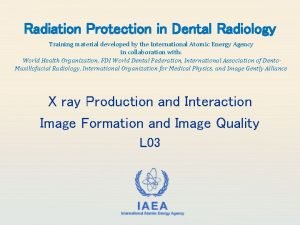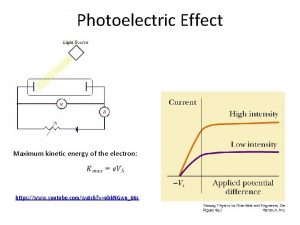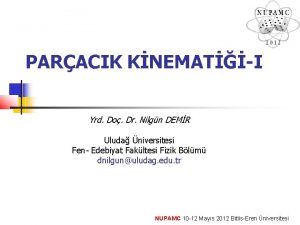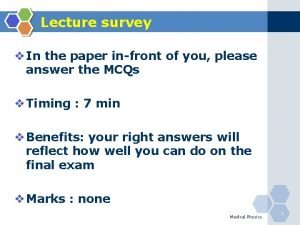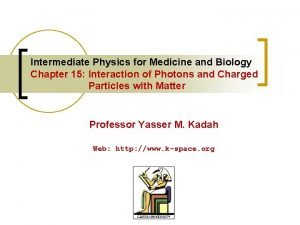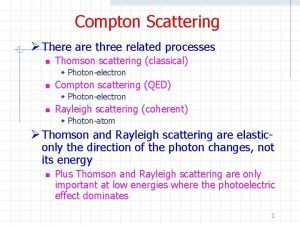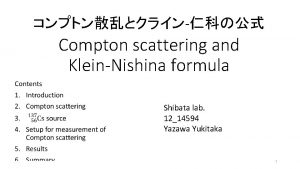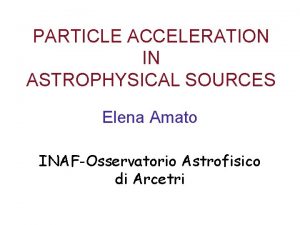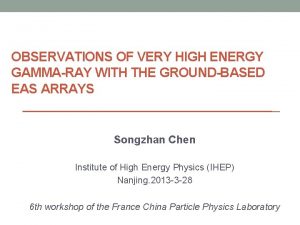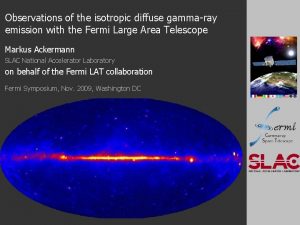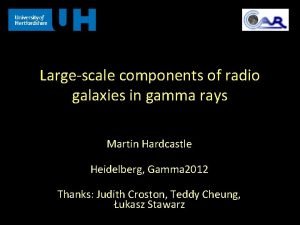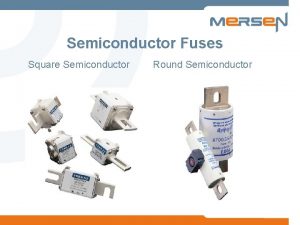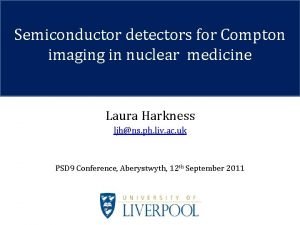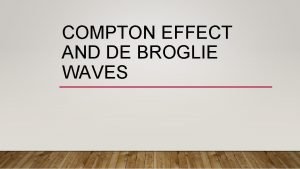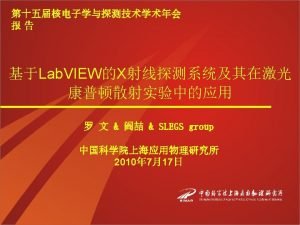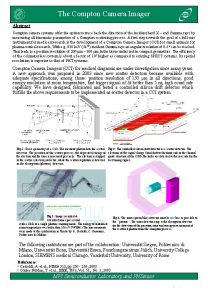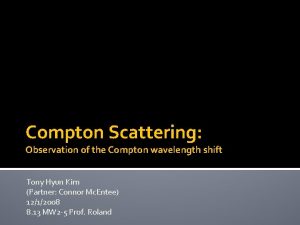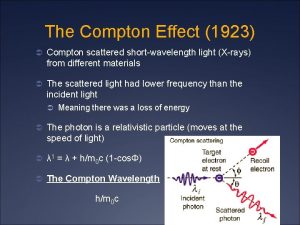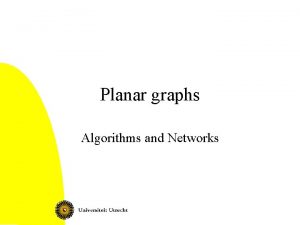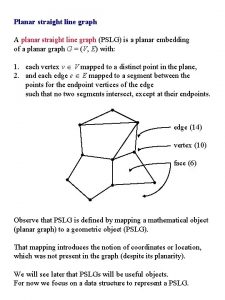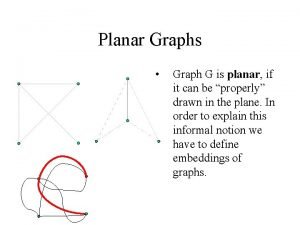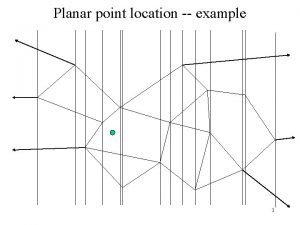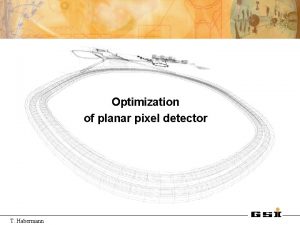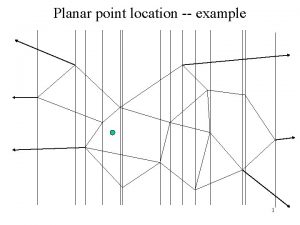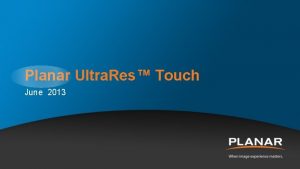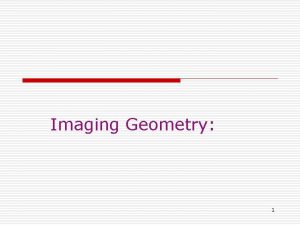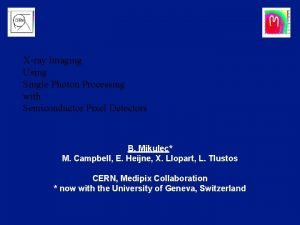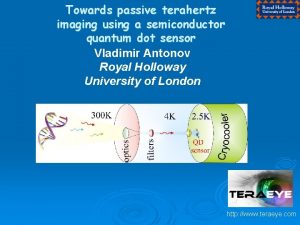Compton imaging with a planar semiconductor system using




















- Slides: 20

Compton imaging with a planar semiconductor system using pulse shape analysis Anthony Sweeney Nuclear and particle physics divisional conference Glasgow 2011

Outline • Motivation • Compton camera principles • Pulse shape analysis • Initial results • Future work

Motivation • Homeland security • Border protection • Nuclear decommissioning • Limitations of existing systems • Pulse shape analysis used to reduce the voxel size

Compton camera principles

Compton scattering Major factors in Compton cameras: • Energy resolution • Position resolution within the detector • Doppler broadening

Compton camera • Compton camera made up from two detectors, scatter (S) detector and absorber (A). • Energy of the incident gamma ray can be found by adding the energy deposited in both detectors. • The position of interaction within the A and S are used to fix the cone apex. • Opening angle of the cone is calculated using the Compton scattering formula. • The source lies somewhere on the surface of the cone. x y z Units mm

Compton image reconstruction • A number of events are recorded. • Cones are reconstructed for each event. • The point where the majority of cones overlap is the most likely position of the source.

Detectors used • Two high purity germanium double sided strip detectors manufactured by Ortec with an active area of 60 x 20 mm. • 24 strips per detector, 12 on each side giving 144 voxels of 5 x 5 x 20 mm. • Individual charge sensitive preamplifiers for each channel. • The preamplifier outputs are digitised through CAEN V 1724 cards. • Typical energy resolutions of 2 to 3 ke. V are seen at 662 ke. V for all strips of both detectors.

Detector and source positions • Detectors are mounted 5. 5 cm apart with the centres aligned. • Separation chosen as a compromise between data collection time and final image resolution. • A 137 Cs point source of 0. 26 MBq activity was positioned 5 cm away from the centre of the scatter detector. • Trigger on a coincident event between both detectors within a 100 ns time window.

Data selection: Fold 1 • Single interactions within the scatter detector and subsequently the absorber detector are needed for reconstruction. • Fold is the number of strips which contain energy for one side of the detector. • Only fold one events from both sides of both detectors are selected. • Each event selected will now only have interacted within one vowel of each detector. g Fold 2

Data selection: Addback • Less energy is deposited in the scatter detector than the absorber. • A spectrum can be created using the fold selected events. • The photopeak seen in this spectrum can be used to identify the source. • Only events within the photopeak of interest will be reconstructed. • Here the 137 Cs 662 ke. V photopeak can with an energy resolution of 3. 7 ke. V.

Pulse shape analysis (PSA)

Depth of interaction • Typical charge collection times t 90 E D C A B ke. V of 200 ns are seen with the detectors used. • Risetimes are dependant upon the time taken for charge carriers to be collected at their respective contacts. • 30% of the total rise time provides information on the primary carrier (t 30). • 90% of the total rise time provides information on the complete charge collection (t 90). • Plotting t 30 against t 90 for all events on one side of one detector a depth of interaction can be measured. • Voxel size reduced to 5 x 5 x 4 mm after 5 regions are selected. A occurs closest to the AC contact, E t 30 closest to DC

Image charge asymmetry neighbouring those carrying pulses, these are image charges. • The size of the image charges can be used to calculate an asymmetry factor. • Plotting this factor, a position within the real charge carrying strip can be found in X and Y for each event. • Using the assumption that there is equal probability for interaction at any point in the strip, the width of the strip can be subdivided into 3, 5 or as many divisions as required. ke. V • Charge is induced in strips

Initial results

Compton image with no PSA • Image assuming the interaction positions are in the centre of the appropriate strip, and the centre of the crystal. • Voxel size 5 x 5 x 20 mm. • Resolution is taken as an approximate full width half maximum of the peaks shown on either side of the image. • Approximate image resolution is 15 mm in X and 17 mm in Y. • The image places the source central to the detector, (330, 330) on the image. • 10401 cones were used for this reconstruction. Colour map represents overlapping cones, units in mm.

Compton image with depth of interaction • This image shows the effect of adding the depth of interaction PSA to the reconstruction. • The approximate image resolution has remained the same (15 mm in X, 17 mm in Y). • The slices through X and Y do however appear visually to be more Gaussian in shape. • The source location has remained the same. • 10401 cones were used for this reconstruction. Colour map represents overlapping cones, units in mm.

Future work

Future work Pulse shape analysis will be applied to all of the strips, currently edge strips are not included. New firmware is being introduced for the CAEN V 1724 s to resolve some issues. A thinner germanium and a silicon-lithium detector will be tested as scatter detectors. Geant 4 simulations will be carried out checking the effects of Doppler broadening, PSA and energy resolution.

Contributors Andrew J. Bostona, Helen C. Bostona, John R. Cresswella, Jamie Dormanda, Mark Ellisb, Laura J. Harknessa, Martin Jonesa, Daniel S. Judsona, Paul J. Nolana, David C. Oxleya, David P. Scraggsa, Mike J. Sleea, Amandeep Thandib a. Department of Physics, University of Liverpool, L 69 7 ZE, United Kingdom b. Atomic Weapons Establishment (AWE), Aldermaston, Reading, RG 7 4 PR, United Kingdom
 Frc control system
Frc control system Echo planar imaging
Echo planar imaging Echo planar imaging
Echo planar imaging Tetrahedral vs trigonal pyramidal
Tetrahedral vs trigonal pyramidal Using system.collections
Using system.collections Kodak 9000 extraoral imaging system
Kodak 9000 extraoral imaging system Digital ultrasonic diagnostic imaging system
Digital ultrasonic diagnostic imaging system X ray protection
X ray protection Work function formula
Work function formula Compton saçılması
Compton saçılması Photoelectric and compton effect
Photoelectric and compton effect Compton scattering formula derivation
Compton scattering formula derivation Compton olayi
Compton olayi Photon cross section
Photon cross section Compton effect formula
Compton effect formula Pion decay
Pion decay Inverse compton
Inverse compton Inverse compton
Inverse compton Ngc 6251
Ngc 6251 übig
übig Hiệu ứng compton
Hiệu ứng compton


